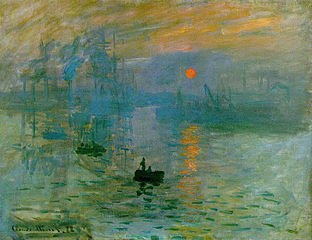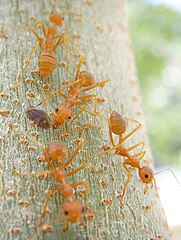User:jonkerz
|


Understanding Wikipedia
| “ | Good order results spontaneously when things are let alone. | ” |
| — Zhuangzi, Chinese philosopher, 4th century BCE[1] | ||
Read this: Spontaneous order, Emergence, Convergent evolution, The Use of Knowledge in Society, Gene-centered view of evolution, Linus' Law, Cellular automaton, Crowdsourcing, Epistemological anarchism, Letter and spirit of the law.
| “ | And thirdly, the code is more what you'd call "guidelines" than actual rules. | ” |
| — Captain Hector Barbossa in Pirates of the Caribbean: The Curse of the Black Pearl[2] | ||
Now you understand Wikipedia!
"War. War never changes."[3]
| “ | The machine-gunners' dreams of point blank fire into serried masses of Emus were soon dissipated. The Emu command had evidently ordered guerrilla tactics, and its unwieldy army soon split up into innumerable small units that made use of the military equipment uneconomic. A crestfallen field force therefore withdrew from the combat area after about a month. | ” |
| — Dominic Serventy on the first engagement in the Emu War[4] | ||
| “ | The men's marathon at the 1904 Summer Olympics in St. Louis took place on August 30 of that year. Thirty-two athletes representing four nations competed, but only 14 managed to finish the race [...] Instead of having the marathon begin early in the morning, St. Louis organizers started it in the afternoon, and temperatures during the marathon reached 32 °C (90 °F). The race began and ended in the stadium, but the rest of the course was on dusty country roads with race officials riding in vehicles ahead of and behind the runners, creating dust clouds. The only source of water for the competitors was a well at about the 11-mile mark [...] The first to arrive at the finish line was American runner Fred Lorz, who had actually dropped out of the race after nine miles and hitched a ride back to the stadium in a car [...] A Cuban postman named Felix Carbajal joined the marathon, arriving at the last minute. He had to run in street clothes that he cut around the legs to make them look like shorts. Not having eaten in 40 hours, he stopped off in an orchard en route to have a snack on some apples, which turned out to be rotten. The rotten apples caused him to have to have strong stomach cramps. Despite falling ill from the apples he finished in fourth place [...] The marathon included [...] two Tswana tribesmen named Len Tau [...] and Yamasani [...] They were not in St. Louis to compete in the Olympics, however; they were actually part of the sideshow. They had been brought over by the exposition as part of the Boer War exhibit (both were really students from Orange Free State in South Africa, but this fact was not made known to the public). Len Tau finished ninth and Yamasani came in twelfth. This was a disappointment, as many observers were sure Len Tau could have done better if he had not been chased nearly a mile off course by aggressive dogs. | ” |
| — Excerpts from Athletics at the 1904 Summer Olympics – Men's marathon | ||
- Funny stories: Emu War (Australia, 1932), Bone Wars (United States, 19th century), Ice block expedition of 1959 (Oslo–Lambaréné), Athletics at the 1904 Summer Olympics – Men's marathon
- Interesting stories: 1907 Tiflis bank robbery, Shakespeare authorship question, Arbre du Ténéré (once considered the most isolated tree on Earth)
- Ghost stories: Goiânia accident (Brazil, 1987), Dyatlov Pass incident (Soviet Union, 1959), Hinterkaifeck (Germany, 1922), Lead Masks Case (Brazil, 1966)
Useful links
- Wikipedia:Unusual articles
- Observations on Wikipedia behavior, excellent essay by Wikipedia's own La Rochefoucauld
- Wikipedia:WikiProject Insects/ant task force (WP:ANTS, WP:ANTS/OA, WP:ANTS/TODO)
- List of the top 200 best Wikipedia usernames
- Template:Wikipedia ads#Hiding the ads
- Wikipedia:How to make dashes
- Stuff
- User:Jonkerz/COI
- Note: I am not jonkerz on Twitter (that's another Swede that I've been mistaken for the past)
- My bookshelf on Goodreads
- Tools
- Wikipedia citation tool for Google Books
- DOI Wikipedia reference generator
- Advisor.js, cleanup script
- User:Dr pda/prosesize, page size script
- User:Fox Wilson/delsort (deletion-sorting categories: organised by topic and organized alphabetically)
Jonkerz Turn of the Century History Museum
Jonkerz Museum of Fine Arts (European Wing) & Ant Zoo
- The Starry Night, van Gogh, 1888
- Wisteria (part of Water Lilies), Monet, 1925
- Montagne Sainte-Victoire, Blick vom Steinbruch Bibémus, Cézanne, c. 1897
- Impression, Sunrise, Monet, 1872
- The Bibémus Quarry, Cézanne, 1885
- Wheat Field with Cypresses, van Gogh, 1889
- The Large Pine, Cézanne, 1890-1896
- View of Toledo, El Greco, 1596-1600
- Charing Cross Bridge, Monet, 1901
- Starry Night Over the Rhone, van Gogh, 1888
- A single colony of the army ant species Eciton burchellii may consist of over two million individuals
- Honeypot ants are gorged with food by workers to the point that their abdomens swell enormously. Other ants then extract nourishment from them. They function as living larders.
- The pain caused by the string of the bullet ant (Paraponera clavata) is purported to be greater than that of any other hymenopteran, and is ranked as the most painful according to the Schmidt Sting Pain Index, given a "4+" rating
- The Argentine ant (Linepithema humile) is an invasive species, thought to live in "mega-colonies"; one in Europe is stretching 6,000 km along the Mediterranean coast
- Camponotus saundersi workers can explode suicidally as an ultimate act of defense[5]
- Weaver ants (Oecophylla smaragdina pictured) make nests in trees made of leaves stitched together using the silk produced by their larvae
- Another weaver ant with an unusual jaw and antennae suspiciously similar to a pair of legs. Nice try Myrmarachne plataleoides; this is actually a spider pretending to be an ant.
- Trap-jaw ants (genus Odontomachus) have the fastest moving predatory appendages within the animal kingdom[6]
- Loved by ant people, hated by trees and leaf collectors; leafcutter ants do not actually eat leaves themselves, but use them to grow fungi
- Another leafcutter ant, Acromyrmex balzani, carrying a leaf
- A green ant...
- ...and some orange ants.
- The black garden ant (Lasius niger) is one of the most common ant species found in gardens in Europe
- Lasius umbratus queens seek out an L. niger worker, kill it to gain the its scent and then discreetly sneak inside its nest to kill the L. niger queen; the workers will care for the new queen's larvae and slowly the colony will become one of L. umbratus.
- Harvester ants (genus Messor pictured) increase seed dispersal by collecting seeds and storing them in granaries in their nests
- The typical colony consists of one or more egg-laying queens, a large number of workers and, seasonally, winged sexual males and females. Here a plaster cast is shown.
- The characteristic jumping motion when in an agitated state gives the jack jumper ants (Myrmecia pilosula) their name
- Meat ants (Iridomyrmex purpureus) feeding on a cicada
- "food robbery and nest-plugging is known to occur" between the meat ant and its competitor, the banded sugar ant (pictured carrying a cocoon)
- The tiny pharaoh ant (Monomorium pharaonis) is a major pest in hospitals and office blocks; it can make nests between sheets of paper
- Turtle ants (Cephalotes clypeatus) at nest entrance
- This ant is made out of gold, really. It has been "sputter coated" with gold to increase visibility for scanning electron microscopy.
- Camponotus sericeiventris on the other hand really is golden, although not made of gold (better image)
- Many forms of green-head ants (Rhytidoponera metallica) have a distinctive metallic green exterior
- A floating plate of ants, the dream of all anteaters. These fire ants are trying to find dry land after having been displaced by rapidly rising water.
- Escamoles al mojo de ajo, nom-om-om! This Mexican dish, consisting of larvae and pupae of Liometopum ants (served with garlic sauce), is likely another of the anteater's favorite snacks.
- The slave-making ant Polyergus lucidus returning from a raid on Formica incerta. Two of the latter already incorporated into the mixed colony are visible to the right of the nest entrance.
- A worker Harpegnathos saltator (a jumping ant) engaged in battle with a rival colony's queen
- Dorymyrmex brunneus tending scale insects for honeydew
- The large blue (Phengaris arion) is a species of butterfly that tricks Myrmecia ants into bringing them to the ants' nest, where they beg for food by acting like an ant larvae
- Listed in Guinness World Records as the "most dangerous ant in the world", Myrmecia pyriformis ants attack by stinging and biting at the same time and is known to have killed humans[8]
- Saharan silver ant (Cataglyphis bombycina) inhabits the Sahara Desert and is one of the most heat tolerant animals known. The ants often traverse midday temperatures around 47 °C to scavenge corpses of heat-stricken animals.
Notes and references
- ^ Murray Rothbard (1990). "Concepts of the Role of Intellectuals in Social Change Toward Laissez Faire" (PDF). The Journal of Libertarian Studies. IX (2): 46.
- ^ See Wikiquote for more quotes
- ^ Iconic catch phrase of the game series Fallout
- ^ "casuariiform". Encyclopædia Britannica. 2009. Retrieved 16 August 2009.
{{cite web}}: Italic or bold markup not allowed in:|publisher=(help) - ^ Jones, T.H.; Clark, D.A.; Edwards, A.A.; Davidson, D.W.; Spande, T.F. and Snelling, Roy R. (2004): "The Chemistry of Exploding Ants, Camponotus spp. (Cylindricus complex)". Journal of Chemical Ecology 30(8): 1479-1492. doi:10.1023/B:JOEC.0000042063.01424.28
- ^ Patek SN, Baio JE, Fisher BL, Suarez AV (22 August 2006). "Multifunctionality and mechanical origins: Ballistic jaw propulsion in trap-jaw ants". Proceedings of the National Academy of Sciences. 103 (34): 12787–12792. doi:10.1073/pnas.0604290103. PMC 1568925. PMID 16924120.
{{cite journal}}: CS1 maint: multiple names: authors list (link) - ^ W. L. Meyer (1 May 1996). "Chapter 23 — Most Toxic Insect Venom". Book of Insect Records. University of Florida.
- ^ "Most Dangerous Ant". Guinness World Records. Retrieved 5 April 2014.

















![Camponotus saundersi workers can explode suicidally as an ultimate act of defense[5]](https://upload.wikimedia.org/wikipedia/commons/thumb/6/6e/Camponotus_saundersi_casent0179025_head_1.jpg/275px-Camponotus_saundersi_casent0179025_head_1.jpg)


![Trap-jaw ants (genus Odontomachus) have the fastest moving predatory appendages within the animal kingdom[6]](https://upload.wikimedia.org/wikipedia/commons/thumb/6/63/Odontomachus_brunneus_worker.jpg/258px-Odontomachus_brunneus_worker.jpg)











![The venom of Pogonomyrmex maricopa is believed to be the most toxic insect venom in the world[7]](https://upload.wikimedia.org/wikipedia/commons/thumb/4/40/Pogonomyrmex_maricopa_casent0005712_dorsal_1.jpg/292px-Pogonomyrmex_maricopa_casent0005712_dorsal_1.jpg)











![Listed in Guinness World Records as the "most dangerous ant in the world", Myrmecia pyriformis ants attack by stinging and biting at the same time and is known to have killed humans[8]](https://upload.wikimedia.org/wikipedia/commons/thumb/6/60/Myrmecia_pyriformis_-_journal.pone.0058801.g001.png/446px-Myrmecia_pyriformis_-_journal.pone.0058801.g001.png)
